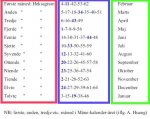Clarity,
Office 17622,
PO Box 6945,
London.
W1A 6US
United Kingdom
Phone/ Voicemail:
+44 (0)20 3287 3053 (UK)
+1 (561) 459-4758 (US).


I have been searching on and off for some time now for this legendary map of Fu Shi, but have not come across it- if anyone has, I’d like to see it.
Right, it's more Daoist garbling. I have gone through several hexagram calendars, and all were garbled versions of the one original hexagram calendar. In the Blofeld calendar, note this sequence of numbers in the second column:
5 16 56 14 50 32 57 54 52 64 3 62
Then, beginning with 5 in the second row of Huang's calendar, note how each of these numbers occurs in descending rows. 62 is in the first row. This can't be chance. Huang needn't bother to say where he got it from. We can figure it out
Legge's Fu Hsi sequence that you have used, is there a pattern that can be discerned
So looking at the hexagrams from a binary perspective, do we get Blofeld's calendar sequence?
Or how does one arrive at Blofeld's sequence?
I did notice, Sven, that you have the marked the winter solstice as hexagram 2 also.
I wonder which one would be historically correct?
♊ ♋
♉ ♌
♈ ♍
--------------------------------------------------------------- equinox
♎ ♓
♏ ♒
♐ ♑I tend to think that the order isn't merely random
I am a microcosm of macro-cosmic forces
Actually: to me remarkable that You asked the question in this thread #1 on the 25 of february...
But according to John Blofeld's table it will be in the third (chinese !) month between the 13' and 18' day. It is in accordance with our april ie. from New Moon in april to New Moon in may.
The I reflects what it is responding on in the nuclear hexagram, and if so, it fits here - at least - by pointing out the time when the accident hindered me in doing my job....
Well, this last point is under the chapter curiousity I know.
Clarity,
Office 17622,
PO Box 6945,
London.
W1A 6US
United Kingdom
Phone/ Voicemail:
+44 (0)20 3287 3053 (UK)
+1 (561) 459-4758 (US).